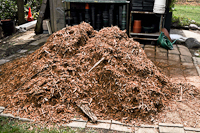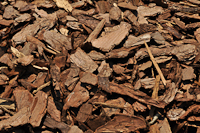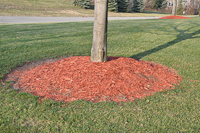 Organic
mulches such as shredded bark, wood chips, bark chips and
others are commonly used on landscape plantings. As with
anything, they have both pros and cons although few would
argue that the advantages do not outweigh the few
disadvantages.
Organic
mulches such as shredded bark, wood chips, bark chips and
others are commonly used on landscape plantings. As with
anything, they have both pros and cons although few would
argue that the advantages do not outweigh the few
disadvantages.
On the plus side,
organic mulches on ornamental beds and borders help to
conserve moisture which helps reduce the amount of irrigation
needed. It also helps keep the plants growing at an even rate
uninterrupted by periods of drought stress.
A two or three inch layer of mulch makes it
difficult for most
weeds to emerge into the sunlight. This
greatly reduces the amount of hand weeding or chemical
herbicides needed for a bed.
Mulch also has an impact on soil
temperatures. For some plants such as clematis, high soil
temperatures are detrimental to maximum growth. A layer of
mulch during the summer helps keep the soil cooler.
Conversely, in the winter, mulch will help to keep the soil
frozen and prevent the damaging effects of the alternate
freezing and thawing of
soils called heaving.
clematis, high soil
temperatures are detrimental to maximum growth. A layer of
mulch during the summer helps keep the soil cooler.
Conversely, in the winter, mulch will help to keep the soil
frozen and prevent the damaging effects of the alternate
freezing and thawing of
soils called heaving.
Since these mulches are organic in nature,
they too will decompose over time. This will result in an
organic layer which is an excellent place for earthworms and
other desirable organisms to thrive.
Finally, organic mulches look good. The
aesthetic properties of much should not be forgotten. A
uniform layer of mulch on all beds in an area will bring a
sense of unity to the layout. It will help tie the beds
together and make them look as if they all emerged from the
same plot.
There are some negatives to the use of
organic mulches but these are generally minor. Of course,
there is usually some cost involved with using the mulches
listed above. Whether purchased by the bag or by the cubic
yard, it costs money to put down mulch. Also, it has to be
applied which takes time and it may need to be replaced over
the years as it decays.
 In
extremely rare instances, plant diseases may be spread by
mulches. The most serious potential seems to be in the
spreading of certain root rots by using the mulch made from
trees that were infected. The best bet is to use materials
that have been partially "composted" by setting in a pile for
six months or more. This will help to minimize this problem.
In
extremely rare instances, plant diseases may be spread by
mulches. The most serious potential seems to be in the
spreading of certain root rots by using the mulch made from
trees that were infected. The best bet is to use materials
that have been partially "composted" by setting in a pile for
six months or more. This will help to minimize this problem.
As these mulches decay, they become
excellent breeding grounds for
slugs. When the mulch becomes
water soaked and slimy, slugs love it. So, if this pest is a
problem, instead of adding new mulch on top of the old, rake
up the old and put it in the compost pile. Replace it with
fresh, new mulch.
Finally, some people do not like the fact
that most mulches lose their looks over time. The crisp,
bright color of the fresh mulch fades away as it ages. There
are even products available to spray on the mulch to keep it
looking fresher longer.



